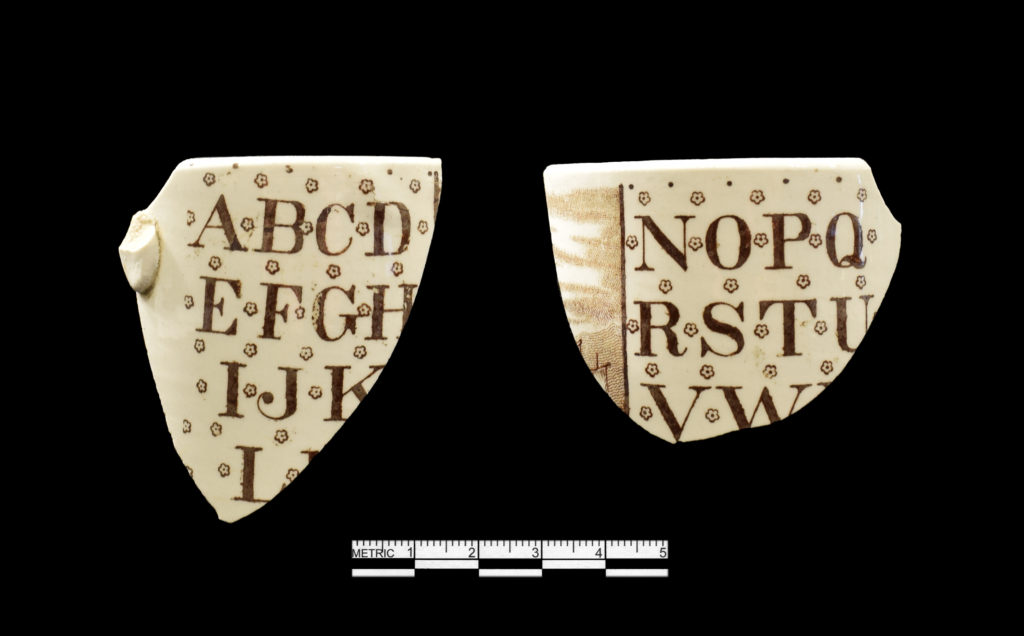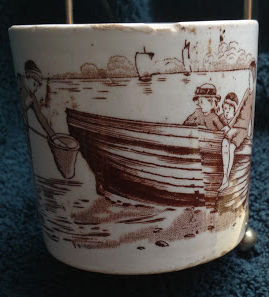Featured Fragment – Marriott Alphabet Cup
By Kerry S. González and Dr. Kerri S. Barile
For this month’s blog we are reaching way back into the archives to one of Dovetail’s first large-scale projects. In early 2006, the City of Fredericksburg and the Inns of Fredericksburg LLC employed Dovetail to investigate the history of a lot on the corner of Caroline and Charlotte streets in Fredericksburg, Virginia, now the location of the Courtyard by Marriott. The study, completed over the course of several months, uncovered more than 300 years of layered occupational history, a common occurrence on urban archaeological sites (Photo 1). These included: 1) part of the foundation of Roger Dixon’s early- to mid-eighteenth-century store; 2) the rear section of the circa 1773–1832 Indian Queen Tavern; 3) a rear work area associated with the Indian Queen; 4) a late-1830s Servant Quarter built over both the eighteenth-century building and the Tavern; 5) an 1840s brick alley wall; and 6) an early-twentieth-century porch stoop. All told, over 70,000 artifacts were retrieved during Dovetail’s excavation, two of which will be highlighted in this post.

Photo 1: Overview of the Marriott Excavation Area Showing the Many Foundations Exposed During the Archaeology Study.
The two artifacts presented in this blog are from an alphabet cup, an uncommon find on archaeological sites. These two fragments represent two sides of one brown transfer print whiteware cup. Alphabet Wares were most commonly produced on plates, with cups seemingly being less favorable to potters. They were first made in England beginning in the late-eighteenth century with production continuing throughout the twentieth century (kovels.com). These vessels were made for children with the intent of teaching them their A,B,Cs. As seen in Photo 2 the alphabet letters on the cup found at the Marriott site are printed in a large, easy to read format. Alphabet Ware plates typically had decorated centers with scenes appealing to a child, such as animals or children’s activities. Cups were decorated with similar childlike motifs like the example shown in Photo 3 that depicts a lazy day on the river.

Photo 2: Alphabet Ware Cup Fragments Recovered During Marriott Excavation Decorated with a Brown Transfer Print and Daisy Motif.

Photo 3: Nineteenth-Century Brown Transfer Printed Cup with Boat Motif on Complete Cup Representing the Same Design on the Cup Found During the Marriott Excavations (Ebay 2017).
This semi-hands-on learning style was not unique to Alphabet Ware or even the late-eighteenth and nineteenth centuries. During medieval times and through the eighteenth century, children used what is known as a hornbook (Figure 1 and Photo 4). A hornbook was a paddle-shaped piece of wood with a piece of parchment or paper containing a lesson affixed to the board. The parchment or paper was mounted in a frame and covered with a very thin piece of horn or mica to keep the parchment intact and safe from a child’s dirty hands. The handle portion was purely to make holding the learning device easier for both the child and the instructor, be it a parent, nanny, or tutor. The lessons typically consisted of letters (sometimes both upper and lowercase) above Arabic numbers followed by the Lord’s Prayer.
According to Moya Cove (2006), the eighteenth-century learning style known as the ‘gingerbread method’ was a direct result of the phonic-based hornbook. In a move away from the monotony of learning letters from a board, teachers and parents alike strove to revive learning by making letters out of gingerbread (Cove 2006). However, years prior to making actual letters from gingerbread dough, baked goods decorated with letters were sold in open market stalls (faqs.org 2006).
Regardless of when and how children learned their letters, the idea of integrating learning into daily life and activities has remained a constant throughout history. Today, homes with children likely have more educational aides than can ever be used. And to think, 200 years ago, simple gingerbread dough and a cup with letters was more than enough. Perhaps they also practiced letters with a stick in the dirt but they certainly managed without all the bells and whistles we have in 2017.
For more information on Alphabet Wares visit the Diagnostic Artifacts in Maryland Webpage which has an excellent article on this type of ceramic and date ranges for the various styles.
Any distributions of blog content, including text or images, should reference this blog in full citation. Data contained herein is the property of Dovetail Cultural Resource Group and its affiliates.
References:
Cove, Moya
2006 Sounds Familiar: The Historic of Phonics Teaching. In, Phonics: Practice, Research and Policy, edited by Maureen Lewis and Sue Ellis, pp. 105–112. Paul Chapman Publishing, Thousand Oak, California.
Ebay
2017 Staffordshire Alphabet ABC Mug. https://www.ebay.com/itm/Staffordshire-Alphabet-ABC-Mug-4-boys-and-a-row-boat-/141806025511, accessed May 2017.
faqs.org
2006 ABC Books. On-line documentation. https://www.faqs.org/childhood/A-Ar/ABC-Books.html, accessed May 2017.
Kovels.com
2011 ABC Plates; Collectors’ Concerns. https://www.kovels.com/20009070881
63/Collectors-Concerns/abc-plate.html, accessed 2011.
Thenonist.com
2003 The Humble Hornbook. On-line documentation. https://thenonist.com/index.php/
thenonist/permalink/the_humble_hornbook/, accessed May 2017.


